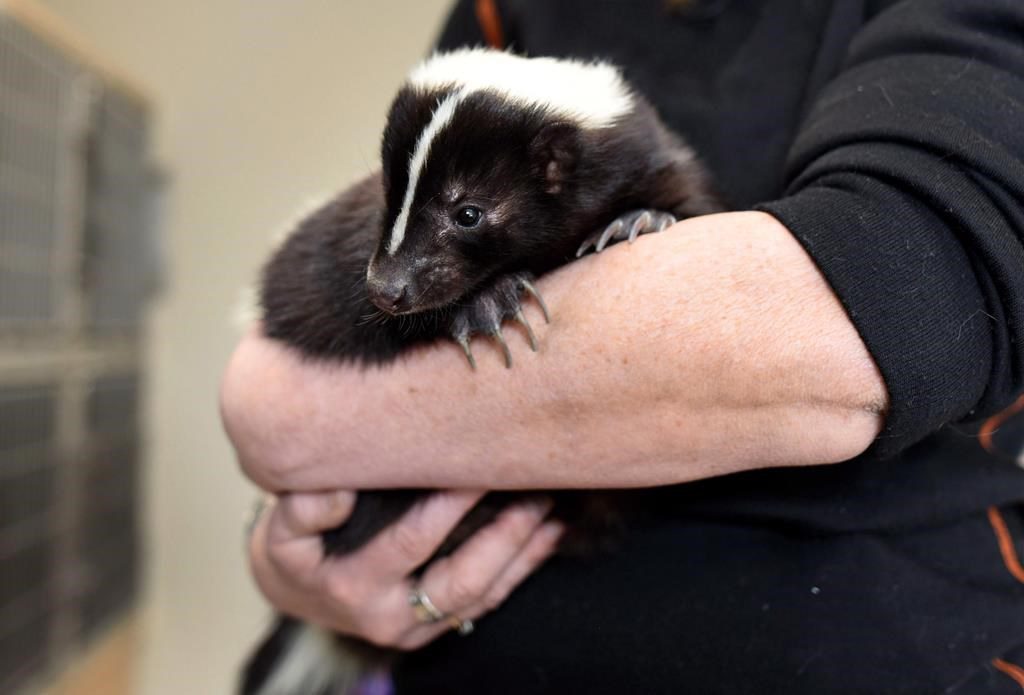Slavko Babincak was getting strange looks while tooling around town one day and couldn’t figure out why.
“Finally two guys asked, ‘Have you been sprayed by a skunk?’ And I’m like, ‘Maybe?'” Babincak recounted.
Perhaps the odour was so strong it killed his sense of smell.
Perhaps he just got used to it.
Either way, he headed home for a shower and change of clothes, chalking up another day trapping skunks in Cold Lake, Alta.
The eastern Alberta city — population 16,300 — has hired Babincak to trap the striped critters and relocate them where they can’t cause a stink for residents.
Cold Lake began offering it as a free service last year, and funding was renewed in its most recent budget.
Babincak has been in the pest control business for more than a decade but began wrangling pests like pigeons and mice as far back as his childhood in Serbia.
Along the way, he’s learned the ways of the black-and-white stinkers – sometimes the hard way.
“If you get sprayed straight in the face, at least for me, it’s just like you can vomit right there,” he says.
And there’s not much that can be done when it does happen.
“People say tomato juice and this and that. Trust me, I tried all this stuff,” Babincak says. “The best thing to use? Nothing really — just time.”
Skunks are mostly mild-tempered and don’t spray often, but “a few times is too many,” he says.
He calls skunks “nomads” often drawn to urban environments where food is plentiful.
Aside from the potential unpleasantness of being sprayed, there’s not much to catching a skunk, he says.
Cat food and sardines make good bait, but skunks aren’t too particular.
“They’re not picky. They’re not complicated. They’re pretty simple animals,” says Babincak. “They need a full belly and somewhere to sleep.”
Sometimes an older, more experienced skunk will become wise to humans’ efforts to trap them, in which case Babincak might have to make sure his scent isn’t on the trap by cleaning it and wearing gloves.
The best solution is common sense prevention, he says. Anyone leaving pet food or garbage in the yard is asking for trouble.
An expectant mama skunk may also hole up beneath a deck or under a lumber pile if there’s nothing to deter her, like a dog.
On the skunk scoreboard, Babincak has a mixed record.
He’s dealt with two skunk calls so far this year: one he caught pretty easily while the other moved along on its own.
Last year he had about 30 calls and successfully trapped roughly half. Often, a skunk is just passing through when it’s spotted and is gone by the time he gets there, he said.
Once skunks are trapped, he drives about half an hour outside Cold Lake and lets them out on Crown land.
One skunk he recently caught was so big that he needed to use a trap big enough for a coyote or fox.
“She was easily 15 pounds if not more. I’ve never seen a big skunk like that,” he says.
The giant skunk’s release was uneventful.
“I opened the door and I sat like five feet away and waited for her to walk out and she started sniffing, and halfway she walked out and started digging some bugs.”
Cold Lake Mayor Craig Copeland says skunk trapping has been an evolving process and one of many unique problems for an urban area that exists on the edge of the forest wilderness.
Alberta Fish and Wildlife officers used to deal with skunk calls. When that stopped, the city started loaning out traps. But then residents would catch the critters – or catch something else – and wonder what to do with it.
So it was time to call professional help.
“It just was a better way to do it than people just signing out the skunk traps and then sometimes they’re catching the neighbour’s cat,” says Copeland.
“Everybody’s supportive. I haven’t run across anybody that’s upset.”
Copeland says Cold Lake puts $6,000 a year toward its skunk program and calls it money well spent. It pays $130 for every trap set up and $250 if a skunk is caught within five days.
Despite Cold Lake’s proximity to wilderness, Babincak says its skunk situation isn’t much different than in bigger cities.
He suspects it’s just that in a smaller community, things can get done more easily and problems get sorted before they begin to, well, smell.
“Everybody pretty much knows each other. You see people all the time, right?” he says.
“So, better communication and that communication ends up in the office where it’s supposed to.”
This report by The Canadian Press was first published on March 23, 2024.
Lauren Krugel, The Canadian Press








